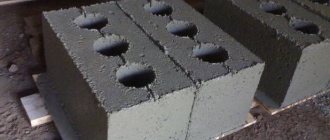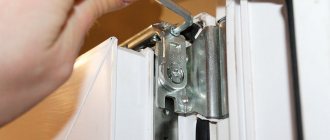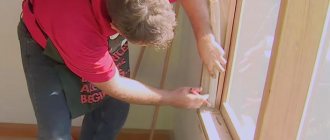Problem #1. Warped sash
If you observe a picture in which the window sash is skewed, determine its nature. It may be unevenly positioned horizontally or sag downwards. For repair purposes, prepare a 4mm hexagon.
Adjusting the “down-up” position
1. To correct the situation, you need to adjust the bottom hinge. It is she who is responsible for the vertical position of the sash.
2. If you want to lower or raise the sash, keep the window in the open function.
3. Unfasten the decorative plastic element covering the loop. Insert the hex key into the adjustment hole at the top.
4. Turn the key clockwise. You will notice that the sash has lifted. If you turn it counterclockwise, it will go down.
5. It is according to the methodology of this plan that repairs and adjustments of plastic windows are carried out. As you can understand, it’s quite easy to do everything with your own hands at home.
Adjusting the left-right position
1. If the goal is to adjust the “left-right” position of the lower area of the sash, work is carried out with the lower hinge. Unfasten the plastic element that closes it.
2. Arm yourself with a key, insert it into the lower groove. Turn counterclockwise, the shutter will turn to the right. If you turn the key clockwise, the window will move to the left.
3. To adjust the position of the upper area of the window, you need to find an element at the very top, which is placed directly on the sash.
4. For better accessibility, open the window wide open. You will see a nest with this element in the upper area closer to the hinges.
5. Insert the hexagon and turn it clockwise or counterclockwise. In the first case, the sash will move to the left, in the second - to the right.
Attention!
Always remember that repairs to the mechanism, namely the position of the sash of plastic windows, are carried out with your own hands exclusively in the open form.
We repair the profile bent by an arc and eliminate the blowing from the hinges
In fact, no type of fittings is protected from bending of the profile and blowing near the hinges.
There may be several reasons. The most common are:
- poor work of the builders who damaged part of the mechanism,
- falling in the middle of the sash of straightening plates,
- or lack thereof at all.
A professional will cope with the task in half an hour, installing the required number of straightening plates in the middle. In fact, the only thing you need to do for this is to remove the bead from the sash.
If you take on this task yourself, you will solve the problem without calling a technician.
Step-by-step instruction.
- “Arm yourself” with a chisel or trowel, it’s better to take it wider,
- Fix the tool at the joint at the sash,
- Apply a little pressure and pry so that the glazing bead comes off,
- Find the straightening plates in the middle between the sash and the frame,
- Move the sash about 3 mm, maybe a little more, placing a plastic spacer under the glass spatula,
- Center the plates. It’s quite possible to make such records yourself, for example, from a stationery ruler. Make sure that the plates have a thickness approximately equal to that of the glass unit itself. And when installing them, make sure that the edges do not rest against the glass. This may damage the glass unit.
Start by moving the sash 3 mm, if it is not enough, add the same amount.
How to fix broken PVC windows yourself
If you need to fix minor damage to a plastic window without the help of a professional, this article is for you.
With the growing demand in the market and the number of buildings and apartments equipped with plastic windows, the number of services to maintain them is also growing. They do not require particularly expensive or sophisticated care, but it must be correct for the window to last a long time.
Over the years, companies offering installation and maintenance of PVC windows, and the users themselves, have compiled a list of the most common problems.
Such breakdowns that you can fix yourself include:
- Handle malfunction
- Limiter failures,
- The sash and/or handle getting stuck when the window is open,
- When it blows at the window joints,
- When it blows near the hinges,
- Damage to the glass unit and/or glass.
Let's take a closer look at each problem and how to solve them.
Everything about replacing handles and stops
When cracks appear on the handle, it breaks completely, or a child appears in the house, this element will need to be replaced. If you choose the option of repairing it yourself, you will need an understanding of what to do.
Step one is to buy a new, working element. Where to buy is up to you - in markets or stores.
Step two is to remove the broken part. How to do it:
- At the base part of the handle we find screws, hidden under the plate,
- We unscrew them and take out the broken handle,
- We install the purchased working part,
- We fasten it with the removed screws.
If necessary, the so-called comb, pay attention to the design of the handle and the structure of the plate. It is simply inserted under the base of the handle, like the ventilation regulator. A screwdriver is also enough to install them.
Problem #2. Large gap during “Ventilation”, blowing from the rubber seal at the top
The windows do not always have vents; they are often absent. Therefore, apartment owners set the “Ventilation” position. If there is persistent frost outside, heat is blown out of the room. Therefore, it is necessary to repair plastic windows and reduce this hole with your own hands.
In the office or at home, sometimes a problem arises when it blows out from under the rubber seal located in the upper area of the window. In such situations, there is nothing else to do but adjust the sash to better press against the frame structure.
Adjusting the size of the gap in the “Ventilation” position
1. If you want to press the upper area of the window against the frame structure, you need to find the mechanism on the window at the top. To gain access, open it, moving the sash to 2 positions at a time. Set it to ventilating and open mode.
2. It is possible that the built-in blocking element will take over the work. It will not allow you to perform 2 actions at once. Then push its tongue inside, located in the handle mechanism.
3. When you finally manage to uncork the window, in the upper section you will notice a scabbard that supports it. There is a regulatory element at the bottom or top of the scissors; it must be turned with a hexagon. The sash will begin to press against the frame. After manipulations, return the window to its original position.
We correct and eliminate the blowing from above from under the sealing rubber
1. When air leaks from under the sealing rubber at the top, repair of plastic windows is carried out with your own hands by pressing the window to the frame structure. If such manipulations are of little use, correction is carried out at home using strips and pins (we will describe it below).
2. As you turn the handle, the locking mechanisms (trunnions) begin to attach to the bars. To adjust the window and eliminate heat loss, you need to adjust either the trunnions or the bars. It all depends on the fittings.
3. Finding the trunnions is not difficult. They look like round/oval elements located on the sash. Determine the trunnion control mode. If there is a hexagon groove, they can be adjusted with a key. In cases where there are no holes, pliers will be needed.
4. Arm yourself with one tool or another, rotate the rounded/oval elements so that they come closer to the sealing gum. Manipulations are carried out with each element that is located on the perimeter of the window. Be sure to make sure the pressure is tight and even.
Adjusting the clamping mechanism
If it blows from plastic windows, this indicates the need to adjust the clamping mechanism or wear of the seals. First, let's look at how the fittings are adjusted. Blows from plastic windows only if the seal of the double-glazed window is broken: there is no alignment of two adjacent sashes. To fix the problem, you need to adjust the eccentrics located at the ends of the frame. To do this you will need a hexagon of suitable diameter.
When adjusting, we advise you not to be too zealous: you only need to tighten the fittings a couple of millimeters. This way you will have a reserve for subsequent adjustments. Adjustments need to be made only when the doors are fully open. We alternately insert the hexagon into the upper and lower eccentric, turn it clockwise and the glass rises noticeably. If you turn in the opposite direction, the sash will lower.
Sometimes the eccentrics cannot be adjusted. Then you need to configure the response mechanism, which is located on the opposite side. This element is fixed to the frame with two bolts, loosening which you can move the locking device in the desired direction.
Please note that the eccentrics and locking pins have special notches that simplify seasonal adjustment of double-glazed windows. For example, in winter the notch should look towards the street, in summer - inside the room.
Typically, windows operate in three positions: open, closed and ventilation. Sometimes the flap operates simultaneously in two positions, which indicates a malfunction of the folding mechanism. This element can also be adjusted by hand. This is done like this:
- We open the window.
- From the end, the locking mechanism will be clearly visible, which must be pressed, and at the same time turn the handle to the position for ventilation.
- The window sash will come out of the groove and a folding mechanism will appear to your attention.
- Adjustment is carried out using a hexagon, with small turns in the desired direction.
Problem #3. Can't close the window (handle jammed)
Do-it-yourself repair of plastic windows is required if the handle gets stuck and you cannot close the window. At home, you need to deactivate the blocking element. It comes into operation if you sharply turn the handle from one position to another. To disconnect, find out the brand of fittings.
"MACO", "WINKNAUS", "ROTO", "GU"
The fittings of the presented manufacturers are slightly different. Inspect the area under the handle; you should notice a tongue protruding at a certain radius towards the frame structure. Press it to move it to a position parallel to the sash. Next, turn the handle.
"AUVI"
Make sure the window is open vertically. If it is tilted and turned at the same time, the hinge blocking element at the top will also prevent you from turning the handle. Find an iron plate with a spring on the side of the sash opposite the handle. Press it against the rubber seal with your fingers and turn the handle.
Attention!
If this does not work, locate the locking element and find out if it is adjacent to the response mechanism of the frame structure. In some situations (for example, a sharp drop in temperature), the blocking element simply slips through.
In order to troubleshoot problems, uncork the window and find the response mechanism on the frame structure (the locking element clings to it).
Unscrew the bolts holding it, place some kind of plate (plastic will do) between the frame area and the counter element.
Replacing rubber seals
If adjusting the fittings did not help and you are still blowing from the plastic window, you need to change the rubber bands that ensure the tightness of the glass unit. Manufacturers strongly recommend that you take care of the rubber seals by regularly wiping them with a damp cloth and lubricating them with silicone grease. People usually don’t do this, as a result the rubber begins to deteriorate, which negatively affects the tightness of the windows.
Changing the seal is not difficult: it is available for sale at any hardware store. Before purchasing, you need to take measurements from the old elastic band. Please note that plastic windows usually have two seals installed: external and internal. We recommend replacing two circuits at once.
The seal is replaced as follows:
- We remove the old rubber bands.
- We wash the groove, removing traces of dirt.
- We insert a new seal, driving it into the groove with any suitable tool.
- Glue the joints.
Problem #4. The handle is difficult to turn
1. Repair of plastic windows should be carried out with your own hands in cases where you are confident that the difficulties that have arisen can be eliminated without difficulty at home. If necessary, it is worth considering the services of a specialist.
2. Often such troubles arise due to sagging sash. The cause may also be dried out lubricant and its absence in the mechanism. Inspect the window and visually determine if there is sagging.
3. If you find something like this, try to adjust the flap in a vertical position. Otherwise, if there is no obvious sagging, the cause will be dried out lubricant. The problem is that the design of such windows is quite complicated.
4. The window is controlled using only a handle thanks to an impressive number of mechanisms. In order for everything to function without failure, lubrication comes into play. It is also important to maintain cleanliness.
5. Use a directional composition for double-glazed window fittings or purchase a universal spray. Inspect everything carefully and lubricate the accessible mechanisms. If the procedure does not help, you cannot do without a specialist.
Cleaning the fittings
The main problem with plastic windows is contamination of the fittings. The entry of dust into the rubbing mechanisms disrupts the operation of the entire PVC structure. To correct the situation, the fittings must be completely removed from the sash and thoroughly cleaned. Please note that before starting work, it is better to photograph the end part of the window so that there are no problems with installing the fittings in place.
USEFUL INFORMATION: Which fittings are best for plastic windows: reviews, rating 2021
Having taken precautions, we unscrew the elements using a screwdriver, lay them out on a flat surface, then thoroughly wipe each element with a rag. Then we lubricate the parts and install them in place. Manufacturers recommend cleaning the fittings at least twice a year. During scheduled maintenance, the elements do not need to be removed from the frame structure.
You can completely change the fittings. To do this, you need to remove the element, look at the labeling and place an order on the manufacturer’s website or in a store.
Problem #5. Broken/loose handle
Repairing plastic windows involves not only troubleshooting technical problems, but also replacing some elements with your own hands. If the handle begins to loosen or bursts, you need to replace it at home.
1. Locate the plastic plate covering the base. Turn it so that the screws begin to show. Arm yourself with a screwdriver and unscrew them. Now there is nothing holding the handle, so you need to remove it. Install a new one in place of the old one, insert the removed screws and tighten them.
2. If you have set a goal for yourself - to replace the opening limiter together with the handle, then before installing a new handle, attach a comb (a plate that controls ventilation) to its base. Next, the handle is placed in its original position and screwed on.
The window is stuck and won't open
In most cases, the reason is the blocker mentioned above, or rather, its untimely operation.
If you inadvertently turn the handle down in the open swing position and then close it, the lock may operate.
The further sequence of actions depends on the model of the mechanism. First you need to try to re-close and open the sash alternately in tilt and turn modes.
If the handle does not rotate fully to any of the open positions, try the following:
- With one hand, lightly pull the top corner near the hinges;
- At the same time, try to rotate the handle to the swing position;
- Place the trunnion clamping eccentric vertically.
There are situations when the handle is not jammed, but, on the contrary, rotates around its axis, but the sash does not react in any way to the rotation. This indicates a breakdown of the fittings and in this case it is unlikely that you will be able to do anything on your own. The good news is that such breakdowns do not occur suddenly, but it all starts with play in the handle, which increases over time. Therefore, if you take timely measures and replace the faulty part, you can avoid unpleasant surprises.
Problem #6. Opening the sash simultaneously in the turning and tilting positions
1. You should not give in to panic ahead of time, even though the window has a fairly large mass. Press it against the frame structure. The loop should fit fairly tightly to the frame at the top. Align the sash vertically.
2. It turns out that the window will be slightly open. Turn the handle horizontally (open). If the process could not be completed due to the blocking mechanism, disable it. After that, close the window and turn the handle down.
3. To ensure the procedure is correct, slowly rotate the handle through all positions. If everything works, you've done it. Minor repairs to the mechanism of plastic windows are a common occurrence. The problem can be fixed with your own hands.
Top corner won't close
The upper part located above the handle may not close for the following reasons:
- The door sagged. In this case, the sagging is not as critical as in the case described above, and the lower part can fall into place. However, the upper pins will touch the striker, which is usually accompanied by a characteristic knock when trying to close the window. The adjustment is made depending on the installed mechanism. In some cases, it is enough to slightly adjust the position of the strike plate: release the fasteners, lower it slightly and fix it. Roto fittings allow you to adjust the angle of the sash.
Adjusting the standard strike plate - The top canopy is not working correctly. This is common with Aubi movements. The hinge rotates, which is why the corner of the sash on top of the handle is not fully pressed. It can be rotated manually to its original position and the window closed. However, this will only be a temporary solution, since the situation will definitely repeat itself soon. Aubi has closed production, so most likely it will be necessary to replace the mechanism with a new one.
Problem #7. Replacing straightening plates if the profile is bent
1. It is not uncommon to feel wind blowing from the hinges. You can try to press the sash against the frame. There should be a hole at the bottom of the loop, use the nozzle and try to tighten it. A similar mechanism should be placed on top.
2. Such DIY repairs of plastic windows should be carried out wisely. At home you need to have the necessary tools. There are enough reasons why the profile arches. Unscrupulous installation is considered one of the main ones.
3. When installing the window, the frame could have been stretched by anchors, as a result the middle clamp simply may not work. Also, one should not exclude the possibility that straightening partitions were not installed at the enterprise, or they fell. The plates are mounted in the middle of the window between the profile element and the glass unit itself.
4. You are very lucky if the windows are still under warranty. Don’t try to fix the problem yourself, call the company and describe it. The master will come and do everything. Under warranty, the defect is corrected free of charge.
5. Otherwise, if the warranty is expired, you will have to install the plates yourself. As a suitable material, it is worth considering plastic approximately in width, not inferior to the thickness of the glass in the window.
6. Use a small spatula. Insert it into the crack between the profile and the bead. Lightly hit the handle of the spatula and move the glazing bead away. Those same plates will be visible from below. They are installed between the sash and the frame itself.
7. Cover the metal part of the spatula with a plastic spacer. As a result, you will not damage the glass unit. Try to move it a few millimeters with a spatula. Place the plates and return everything to its place. They should not touch the glass, otherwise the glass unit may be damaged.
Plastic windows
88 votes
+
Vote for!
—
Vote against!
High-quality plastic windows from a trusted manufacturer, installed in compliance with all the subtleties of technology by good craftsmen, can last for many years without causing any trouble to the owners. But suddenly it began to blow from somewhere, the handle broke, the seal cracked, or the handle simply jammed. In such situations, plastic window repairs are needed. Don’t panic and immediately look for a repairman; many breakdowns can be fixed on your own in just a few minutes.
- Do-it-yourself adjustment of plastic windows
- Adjusting the sash position “up and down”
- Adjusting the sash position “right - left”
- Adjusting the sash to press against the frame
- Do-it-yourself plastic window repair
- Installing a new handle and opening limiter
- The handle is stuck in the “open” position, the window sash does not close: disabling the lock
- The handle turns with difficulty or does not turn completely: hardware repair
- The sash opened simultaneously in swing and tilt modes
- Blowing from under the seal: pressing the sash to the frame
- Blowing from the hinge side, arched the profile: installation of straightening plates
- Old plastic windows: hardware repair
- Replacing the seal on plastic windows
- Replacing double glazing in a plastic window
- Repair of plastic windows: video instructions
Do-it-yourself adjustment of plastic windows
If the window sash suddenly becomes warped: it sags downwards or is positioned unevenly in the horizontal plane, adjusting its position will not be difficult. You must have a hex key set to “4”.
Adjusting the sash position “up and down”
The position of the sash in the vertical plane is adjusted by the lower hinge. To raise or lower the sash, open the window and remove the decorative trim from the bottom hinge. Then insert the hex key into the adjustment groove, which is located on top. Turn clockwise - the sash rises, counterclockwise - the sash lowers.
Adjusting the sash position “right - left”
The “right - left” position of the lower part of the sash is adjusted using the lower hinge. In the same way, remove the decorative trim and insert the key into the adjustment groove, which is located below. Turn clockwise - the sash moves to the left, counterclockwise - the sash moves to the right.
The “right - left” position of the upper part of the sash is regulated by an element that is located at the top of the sash itself. To have access to it, we open the sash wide, from above, on the side closest to the hinges, we see the slot in which the element is located. Using a hex key, turn it - the sash moves left or right.
Important! The position of the shutters can only be adjusted when they are open.
Adjusting the sash to press against the frame
Most often, plastic windows do not have vents, so the only way to freshen the air in the room in winter is to put the sash in the “ventilation” mode. For very severe frosts, the gap formed may be too large - all the heat will blow out through it. There is a need to reduce it, at least temporarily. Or another problem arises: there is a lot of blowing coming from under the seal. In this case, adjustment and repair of plastic windows may be necessary.
The pressure of the upper part of the sash to the frame is adjusted by a mechanism on the upper sash. To have access to it, we open the sash in two positions at once: “open” and “ventilation”. If the lock is activated, preventing you from opening two positions at once, press in its tab located on the handle mechanism. When the sash is open, we see scissors from above that support the sash. There is an adjusting element at the top or bottom of them; we turn it using a hexagon. The sash will be pulled closer to the frame. Then we return the sash to its original position.
Blowing from under the seal can be eliminated by pressing the sash against the frame. If this does not help, repair of plastic windows (PVC) will be required. You can adjust the sash pressure using the locking mechanism of the trunnions and strikers , which are used to open and close the window. When the handle is turned, the trunnions engage the strikers. Either one or the other can be adjusted depending on the fittings.
Trunnions are located on the sash and are round or oval elements. If they have a hexagonal groove, then they are operated with a key, and if not, you need to use pliers. We rotate the trunnions so that they become closer to the seal. We repeat this procedure for all trunnions that are located around the perimeter of the sash. Make sure that the pressure is even.
Do-it-yourself plastic window repair
For new plastic windows, repairs and maintenance are covered under warranty only if the warranty is provided by the manufacturer or installer. The average warranty period is 2 years. If the breakdown occurs after this period, you will have to carry out paid repairs. Below is information that will allow you to save money and not call a plastic window repair specialist for trifles.
Installing a new handle and opening limiter
If the handle suddenly breaks, cracks or becomes loose, or you want to install an opening limiter or a new handle-lock so that a child cannot open the window, you do not have to contact special companies. It is enough to buy a new handle at a hardware store and replace the old one with a new one yourself.
Turn the decorative plate at the base of the handle 90°. We see two screws, top and bottom, that secure the handle. Unscrew them with a regular screwdriver and remove them. We remove the old handle. We install the new handle and fasten it with the same screws. If we want to install an opening limiter, then before installing the new handle, we install the ventilation control plate (“comb”) into the base of the handle. Then we put the handle on, screw it on and turn the plate back to cover the screws.
As you can see, everything is quite simple. If possible, it is better to do this work yourself, since the prices for such repairs of plastic windows are the same as for new handles. Those. the cost of a new handle = the cost of installing it. Why pay more?
The handle is stuck in the “open” position, the window sash does not close: disabling the lock
Don't be alarmed if the handle is stuck in the open position. Most likely, the blocker was activated. It is installed on most fittings for a good purpose - so as not to accidentally break the window. When the handle is turned to the tilt or tilt position, the lock is activated to prevent the handle from turning. But there are times when it works at the wrong time. Most often this happens if the handle is moved too quickly from one position to another. To disable the blocker, you need to determine the brand of hardware.
Fittings "AUBI" : The sash must be in a vertical position. If it’s a tilt-and-turn type, the lock on the top hinge will also prevent the handle from turning. In the area of the handle we find a metal plate with a spring. We press it against the seal with our fingers and turn the handle.
Fittings “Roto”, “GU”, “Winkhaus”, “Maco” : under the handle we find a metal tongue, it should stick out at an angle to the frame. We press on the tongue so that it is in a position parallel to the sash, and turn the handle.
If this does not work, you need to check whether the lock is in contact with the response mechanism on the frame. There are cases of thermal expansion, then the blocker can slip past. To eliminate this, open the window and find a counter element on the frame to which the blocker should cling. Then we unscrew the screws that secure it and place something between the frame and the counter element, for example, a plastic pad. This way we will ensure that the blocker on the sash engages with the counter element on the frame.
The handle turns with difficulty or does not turn completely: hardware repair
Problems with the handle may be caused by sagging sash or dried grease in the fittings. First, we look visually to see if there is sagging. If there is one, adjust the sash in a vertical position, as already described above. If you don’t notice anything like that, then it’s still a matter of lubrication. The fact is that the fittings system for a plastic window is very complex. Control, in fact, using only one handle is ensured by a large number of transmission mechanisms. Their high-quality work is guaranteed by cleanliness and good lubrication. Therefore, we buy either a universal penetrating lubricant or a special lubricant for plastic window fittings and lubricate all moving elements of the fittings. If the handle still doesn’t move well, then you should call a technician.
The sash opened simultaneously in swing and tilt modes
We don’t panic, it’s clear that the sash is heavy, but still... We switch it to the rotary mode, i.e. Place it vertically so that the top loop is pressed.
At the same time, the sash remains open. We move the handle to the horizontal position (“open”). If the blocker does not allow it, disable it, as already described above. Then close the sash and turn the handle down. To check, we slowly turn the knobs to different positions, it works - everything is fine.
Blowing from under the seal: pressing the sash to the frame
First of all, we try to cope on our own, pressing the sash more tightly to the frame. To do this, follow the clamping instructions as described above. We pay attention to the position of the trunnions and strikers, whether they correspond to each other.
Perhaps the trunnions do not extend beyond the mating parts. In this case, it is necessary to rearrange the slats: unscrew the screws securing them and rearrange them a little lower. If nothing helps, everything is still blowing, then the reason is different. Contact a specialist.
Blowing from the hinge side, arched the profile: installation of straightening plates
If it is blowing from the side of the hinges, you can press the sash in this place to the frame. There is a hole on the bottom loop, insert the nozzle into it and turn it.
On the top hinge, the tightening mechanism is located on the scissors, as it is adjusted as described above.
If the profile is bent in an arc, there may be several reasons for such an ailment. The first is poor-quality installation: the frame is stretched by anchors, and the middle clamp does not work. The second is that the straightening plates fell or were not installed at production (defective). They must be installed in the middle of the sash between the double-glazed window and the profile. If your windows are under warranty, do not carry out repairs yourself, contact the company, they are obliged to fix the defect free of charge. If the warranty period has long passed, then we install these plates ourselves. As a material, we use any available plastic, with a width no less than the thickness of the double-glazed window.
We take a metal spatula, place it in the joint between the bead and the profile, lightly hit it and disconnect the bead. Below we see the straightening plates installed between the frame and the sash. We cover the metal part of the spatula with a plastic stand so as not to damage the glass unit. Use a spatula to move the glass unit back 3 – 5 mm. We install the plates and return the glass unit to its place.
Important! Plastic plates should not rest against the glass part of the glass unit, otherwise the glass may crack.
Old plastic windows: hardware repair
Over time, the window fittings become clogged with dust and dirt and cease to function normally. And there are cases that during repairs the windows are open, and the whitewash clogs all the transmission mechanisms - the new windows stop working. You will have to completely go through the fittings. You can order this work from professionals. Such repairs of plastic windows in Moscow will cost from 1,200 rubles. for one leaf. Or you can try to do it yourself.
Remove the sash from its hinges. Remove the decorative trims from the top and bottom hinges. We knock out the axle from the top loop: first we hit it from above, and then remove it from below using pliers. Someone else must support the sash at this time, since it is heavy. We remove the sash from the bottom hinge and place it on the table. Remove the handle (see above). Along the perimeter of the entire sash, unscrew all the screws securing the fittings. We take out the mechanism of their special groove. We place the fittings on a table covered with film. We wash the entire mechanism with a brush, dipping it into the rinsing bath.
After thorough washing, dry the mechanism with air. You can use a bicycle pump. We buy a special lubricant for plastic window fittings and lubricate all transmission elements and rubbing parts.
Carefully put the accessories back on. We fasten it with screws. Install the handle. Lubricate the hinges and hang the sash. If everything works well, we've just saved RUB 1,200.
Replacing the seal on plastic windows
The average service life of a seal is 5 – 10 years. If you can see with the naked eye that it is out of order and worn out, it’s time to replace it. First of all, we buy a new one. German will last 10 – 15 years. Turkish – 5 years. When purchasing, we check along the entire length to ensure there are no defects.
We take out the old seal and groove. Clean and rinse the groove thoroughly. Lubricate the groove with glue along the entire perimeter. We insert the seal into it slowly and carefully - do not allow the cord to stretch or shrink.
Replacing double glazing in a plastic window
A broken double-glazed window is another nuisance. If you are not confident in your abilities, it is better to contact specialists. In any case, we will need to order a new double-glazed window.
We remove the old glass unit. Using a metal spatula and a rubber mallet, remove all the glazing beads. We insert the spatula into the joint between the frame and the glass unit, lightly hit it and remove the glazing beads. When all the glazing beads are removed, we take out the double-glazed window - together, it’s heavy. Carefully lay it on the floor. We measure all parameters: height, width, thickness. We inform the manufacturer of the dimensions and wait for new double-glazed windows.
We install straightening plates at the bottom - if the sash is blind, in the corners with an indentation of 10 cm - if the sash is opening. We insert a new double-glazed window. Let's make sure its geometry is correct. If necessary, add more straightening plates. Then we install the glazing beads. The new window is ready.
Important! Replacing a double-glazed window in a wooden window uses a different technology using more serious tools, so you should not try to do it yourself.
In this article, we examined only those breakdowns that you can try to fix yourself. If something more serious has happened, or you can’t do it yourself, contact special companies.
Repair of plastic windows: video instructions
Problem #8. Blowing from under the seal
1. To make the repair of plastic windows as productive as possible, follow the instructions. The problem can be resolved with your own hands using simple tools. You can fix almost anything at home. To do this, press the window firmly against the frame.
2. Look carefully to see if the position of the strikers and trunnions matches each other. Most likely, something doesn't add up. Unscrew the bolts (fastening) and move them a little. If the procedure turns out to be useless, call the specialist.
The door hung on one hinge
In such situations, the sash is held in the frame by the lower canopy and upper “scissors”. The breakdown is eliminated as follows:
- We put the top of the sash in its working position - as if nothing had fallen out. To do this, you need to gently press the upper corner with your palm until it stops; you should not apply excessive force.
- Pressing the lock with your finger, place it vertically and turn the handle horizontally. The main thing is that the upper corner is pressed at this time.
- When the upper mechanism catches on the hinge, you can close and open the window in the usual way.
The most common cause of such a breakdown is considered to be incorrect operation of the fittings combined with the human factor. The window is transferred from the ventilation mode to the swing mode without completely pressing the top of the sash to the frame.
Instructions for old windows without a lock
Problem #9. Mechanism malfunction
1. There is no escape from the fact that after some time the fittings become clogged with dust and cease to normally perform their direct duty. In this case, you can ask for professional help or do the repairs yourself.
2. Remove the window from its hinges. Unfasten the decorative trims from the latter. Knock the axles out of the hinges, then try to pull them out with pliers. Work with a partner. The sash is quite heavy and needs to be held.
3. Remove the handle and unscrew all the screws around the perimeter of the sash that hold the fittings. Carefully remove the mechanism from its seat. Cover the table with film and place the fittings on it. Wash the product with a special liquid and brush.
4. After carefully performing the procedure, dry the mechanism. You will also need a directional agent for the fittings. Process all the mechanisms that are involved in the system.
5. Don’t think that everything can work out without problems. Repairing plastic windows with your own hands is a painstaking task. All tools must be available at home. Reassemble the sash and fittings in reverse order. Grease the hinges and hang the window.
The hinge is broken
The problem is widespread primarily on large sashes, especially if they are often opened in the swing mode. The entire load, and not a small one at that, falls on the lower hinge and soon its body cracks or, what happens less frequently, the screws break off. The only way out in such situations is replacement.
To make the procedure go faster and all other elements of the window to remain intact, it is better to change the hinge together. The situation can be aggravated by the breakdown of the upper hinge, since the massive sash, with the lower canopy turned out, significantly pulls on the top and often deforms its parts.
Sequencing:
- Remove the decorative trim from the hinges;
- Open the window slightly in swing mode and partially knock out the supporting axis with a hammer;
- A part of the axial mechanism will appear from below, pinch it with pliers and pull down until it is completely removed;
- Hold the sash, pull it slightly towards you, then lift it up. This should release the lower support. There is no rigid fixation at the bottom, so you just need to move the sash to the side and remove it from the frame.
Replacing the hinge is done with improvised tools, depending on the type of fastener.
What are window fittings?
A special metal structure consisting of tilt-and-turn elements is installed on balcony doors and room windows. These parts allow moving wings and doors to swing open completely or extend from above while in a stationary position. In the second option, the lower part of the sash remains attached to the frame. To adjust the tilting depth, there are special scissors with a limited stroke. To open the doors, you must first overcome the resistance provided by the seal.
There are several types of fittings for PVC windows and doors:
- folding transom sashes;
- tilt and turn;
- rotary.
Basic elements of window glazing
the following:
- Frame. Each window has a supporting frame made of PVC profile, which is reinforced with metal.
- Sash. To open the window, sashes made of reinforced profiles are placed inside the frame. If opening is not necessary, then the glazing is done directly into the frame.
- Impost. This is the internal part of the frame, which serves to provide the necessary rigidity and divide it into parts.
- Glazing bead. Fixes infill elements such as sandwich panels and double-glazed windows. This is a removable structure made of PVC profile. It is equipped with a rubber seal.
- Double-glazed window. The transparent filling of the frame opening consists of 2 or 3 glasses. They are separated by a spacer frame containing moisture-absorbing material.
- Accessories. A unique set of mechanisms and components that ensure the fixation and functioning of window sashes when they are opened and closed.
- Windowsill. An element of covering the internal space at the bottom of a window block. The most common products are made from hollow plastic profiles. Expensive and practical options are solid reinforced polymers.
- Low tides. A plate made of metal or polymer with a specific profile composition. It is installed from the outside to drain water.
Reference Information! During installation work, profiles are also used to help correctly connect the parts of the block. Peculiar panels form internal and external slopes. The junctions can be covered with decorative overlays. The presence or absence of these parts is determined by the brand of the window model and its manufacturer.
We repair window locks and locks
Now there are many models of PVC windows on the market, and in particular turnkey fittings. Such methods help to be calm when there is a child in the house.
These locks also require maintenance and can break down. Most often this happens when:
- The lock itself is defective or of poor quality,
- It broke due to external mechanical influences,
- It failed over time and became worn out.
And replacing one lock is much more reasonable and cheaper than completely changing the fittings.
The handle is tight and/or does not reach the end
Before calling a technician and disassembling the fittings, lubricate the moving parts. Lack of lubrication can cause all the problems. Regular WD-40 purchased for the car will do.
But spare parts need to be worked out efficiently. Therefore, take lubricant with a special tube, or use improvised means such as a brush, syringe, or cotton swab on a stick.
Only if lubrication does not help, move on to heavy artillery - try to eliminate the sagging of the sash.
Step one - take a four-point hex key and find the hinges of the sash. Step two - tighten the screws in the hinges, bottom and top, if necessary.
Draws air into the seal area
The PVC window fittings include a part with which you can change the clamping force. This part is called an eccentric or trunnion, and working with it will help eliminate this problem.
Trunnions can be found on the frame, on its inside. It is located just opposite the handle, but can be hidden under the panel.
Step one - remove the cover and find where the hex key goes in (the same 4-piece), Step two - find a point or strip on the eccentric, Step three - insert the key, adjust the trunnions according to the principle: the mark indicates the degree of pressing more from the outer edge , less towards internal.
Difficult to turn the handle completely
Another common problem. If the problem is not irreversible, most likely it is due to sagging of the sash, or a simple lack of lubrication.
You can fix the last problem using basic car WD-40. But, if such steps do not help, you will have to take a screwdriver. Or rather, for a hex key.
Step one - observe whether the sash is in contact with the stop on any side, and how smooth it is.
Step two - remove the plates installed to protect the hinges,
Step three - use a wrench to tighten the hinge fasteners.
Do-it-yourself repairs
Regular maintenance (at least once every 3-5 years) can help prevent serious problems or breakdowns of plastic structures. What is the user's task?
- Checking the condition of installation seams, the level of wear of insulation and replacing materials that have lost their suitability.
- Adjustment of the movement of the valves. There should be no obstacles or friction when moving them.
- Lubrication, as well as timely replacement of worn-out mechanisms.
With the right approach, the service life of metal-plastic structures can be at least fifty years.
Proper operation becomes a way to prevent various breakdowns. The most common troubles:
- failure of fittings;
- sagging lines;
- shrinkage or rupture of sealing material;
- changing profile geometry;
- the appearance of condensation;
- increased sealing of the room (with the window closed).
Attention on the part of the user and regular maintenance will prevent the occurrence of problems, as well as the need to replace the product.
When to replace?
For example, if a plastic window does not open. As soon as the windows begin to function differently than before during installation, they immediately require checking and adjusting the incoming elements. If this is not done in time, then loosening and damage to the parts of PVC windows will continue to occur and the entire window panel may need to be replaced. Damaged fittings can cause problems with the window such as drafts, freezing of glass, extraneous sounds entering the room, noise from the street, condensation and dust settling on the windows.
You can correct the following faults on your own, which lead to the above-mentioned consequences: a broken handle and a bevel of the sash in height or in relation to the frame. Plastic windows need adjustment.
Repair of PVC windows in detail and adjustment of plastic windows video:
Author: Sergey Vladimirovich, electrical engineer. More about the author.
Leveling the sagging sash
A slight misalignment of the window sash may occur, and this is completely normal, since it bears the weight of the entire glass unit. In order to level it, you need to remove the trim from the bottom sash, and, opening the window slightly, using a hex key, begin to level the sash in a horizontal position. To raise the sash, the key must be screwed in, and to lower it, vice versa. In this case, you must rotate the key counterclockwise.











